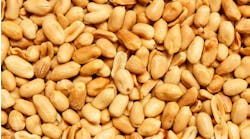The push is on. A multitude of food industry stakeholders advocate increased consumption of plant-based foods. “Plant-based products are not only sought after by core vegan or vegetarian consumers, but by shoppers aspiring to have a healthier diet or following a flexitarian lifestyle," points out Mandy Bottomlee, director of content marketing at 2020 R&D Team winner Good Foods Group, which makes mostly plant-based dips, salad dressings and juices.
Fortunately, “Formulators of processed foods and beverages have an abundance of protein sources from which to choose," says B. Pam Ismail, professor in the Dept. of Food Science and Nutrition at University of Minnesota and director of the Plant Protein Innovation Center (PPIC). "Cost, supply reliability and safety are important factors. Additionally, much research is going into how to improve emerging plant proteins’ key attributes of flavor, functionality and nutrition.”
Consumers frequently compare taste and nutritional attributes of plant-based alternatives to traditional animal based-products, with animal sources often holding their own. Some three in 10 respondents to International Food Information Council's 2020 Food & Health Survey report never consuming plant-based meat and dairy alternatives.
However, the same survey found the perceived healthfulness of animal protein is up since 2019. Thoughtful formulation efforts and advancing plant protein technologies can improve the competitiveness of these sources.
For example, almonds possess 6g of protein and 4g of fiber per one-ounce serving, says Harbinder Maan, associate director of trade marketing and stewardship at Almond Board of California. While whole, flaked and granulated almonds provide visual and texture appeal to foods, almond flour, available in a variety of forms and grinds, including defatted almond flour—also known as almond protein powder—offers increased flexibility in formulating products.
The Protein Digestibility-Corrected Amino Acid Score (PDCAAS) of a formulated food is an important factor for nutritionists and increasingly to product developers. This score relates to a protein’s quality based on human amino acid requirements and the ability to digest the protein. A higher PDCAAS value for a consumer product means a higher percent daily value (%DV) and the possibility of making a protein marketing claims.
Ingredient blending tactics can increase that score. To help a product achieve a higher %DV, almond protein can be combined with a complimentary protein for a more optimal amino acid profile, notes Swati Kalgaonkar, associate director of nutrition research at the Almond Board.
The USDA’s FoodData Central lists 100g unroasted almonds as having 0.568g lysine, 0.157g methionine and 0.215g cysteine. Blending such an ingredient with legume or pulse-based products that are lower in methionine and cysteine may be able to improve the overall %DV of a product while listing consumer-friendly ingredients on the label.
Mimicking meat
“Over the past decade, sales of plant-based 'meat' have skyrocketed, with U.S. grocery sales rising to $939 million," says Jacquelyn Schuh, product marketing director for alternative proteins & specialty ingredients at ADM. “Today, 44% of North American consumers self-identify as flexitarian, prioritizing a reduction in overall meat consumption and adding more plant-based foods to their diets.”
Plant-based meat alternatives are often looked at as a new category. However, industrially produced plant-based analogues have been around for over half a century, especially at ADM.
“The original textured vegetable protein or TVP, which we helped to formulate and is a trademark of ADM, was invented by William T. Atkinson in the 1950s and 1960s,” says Schuh. Atkinson developed a process to “texturize” soy flour into a meat-like substance using an extruder with mechanical shear and heat, combined with the injection of water. “The original TVP was a fibrous, spongy material used as a stand-alone meat alternative product, as well a nutritional extender in meat and poultry products to reduce costs and increase protein content.”
Through the years, technological advances in processing and ingredients led ADM to expand its textured protein portfolio. Ingredients with more neutral flavor and light color profiles were developed to ensure that product developers could start with a “blank slate” when creating applications such as chicken, fish and seafood.
Other examples of ingredients designed for specific applications include ADM’s recently introduced lines of textured pea proteins and textured and non-textured wheat proteins. Prolite MeatTex and Prolite MeatXT wheat proteins contribute meat-like texture for meat and seafood alternative products.
Knowing the importance of PDCAAS led ADM to develop its Arcon T textured pea protein ingredients. One form blends pea and chickpea protein, while a second blends pea protein and navy beans.
“They deliver improved hydration properties and offer a higher PDCAAS score,” says Schuh.
Sweet Earth, a Nestle brand, uses “vital wheat gluten” as the base for its sham ham.
To meet specific label requirements and desired finished product attributes, formulators can move beyond use of whole components such as nuts, seeds, pulses and textured protein ingredients to add functional protein powders. “Consumers often want a plant-based chicken-style patty to have the same appearance, bite and flavor as a traditional chicken,” says Schuh. One tactic is to blend a high-quality textured soy protein concentrate with an ingredient like ADM's ProFam soy protein isolate.
Performing protein properties
With decades of research and commercial development behind soy ingredients, they still dominate the plant protein marketplace due to their benefits as fortifiers and functional additives.
However, “Pea proteins have increasingly competed with soy in the past five years,” says Ismail. Currently there is a lot of research into enhancing their production processes to expand the functionality of these ingredients. Other market newcomers such as flours and proteins from other pulses (e.g., chickpeas, lentils, fava and mung beans) have similar environmental benefits and are being looked at for their nutrition and functionality.
Innova Market Insights data from this June analyzed the top five ingredients used as alternative proteins (as a percent of 2019 global food and beverage launches tracked with alternative proteins). Wheat gluten was used in 44% of the new products; soy protein and soy protein isolate in 17% and 11% respectively; hydrolyzed vegetable protein and pea protein each claimed 8% of new launches.
“Research is ongoing into how to improve the functional properties of the many emerging plant-based alternative proteins,” says Ismail. Although there are protein powders such as hemp, sunflower and others for consumer, foodservice and other users who simply wish to blend extra protein into a product, more research is required if used for functionality in industrial formulations, Ismail adds.
Research at PPIC also is looking into leaf sources of proteins (e.g., alfalfa as well as its seeds), nuts and certain grains, particularly oats, rice and corn (the last is more of a challenge). There also is much interest into how to use hemp seed as a source of protein; also oilseed crops beyond soy, such as sunflower, canola (or rapeseed), camelina and pennycress.
Much of Ismail’s research focuses on enhancing protein functionality through optimized extraction processes and modification. During processing, conditions such as temperature, shear and pH changes can cause proteins to unfold (i.e., denature) and aggregate. Protein aggregates are not soluble and thus may have poor functionality in some applications.
Merit Functional Foods is an example of one company that has focused on manufacturing to produce differentiated protein ingredients. “Our process for making pea protein differs from most other protein extraction processes,” says Co-CEO Ryan Bracken. Unique and useful ingredient functionalities have been developed by modifying the ratios of certain protein types or classes in the finished protein ingredient.
The label may say “queso” (also “-style”) but Good Foods’ Queso Dip is plant-based, with its protein coming from almonds and chia.
The company also concentrates and purifies its pea proteins using membrane technology. This technology has several advantages, notes Bracken. Not only is most of the protein’s native functionality maintained, but off-flavors, compounds that cause dark coloration and even anti-nutritional factors are reduced or removed. “The resulting protein is light in color, low in pea flavor intensity and higher in digestibility and solubility. This translates to a creamy, dairy-like experience when using our Peazac 850 in ready to mix protein powders.”
To back its belief that the new ingredient had a milder flavor profile, Merit conducted a third-party proprietary research study using descriptive analysis to identify key flavor descriptors common to all pea proteins. “Findings indicated that Peazac 850 is very low in flavor intensity and bitterness compared to other pea proteins manufactured in different geographical locations,” Bracken says.
The company also relays that the ingredient’s higher solubility across a wide pH range enables a creamier mouthfeel in various applications without added texturizing ingredients. The creation of great tasting plant-based protein alternatives becomes even more challenging when clean labels are also the goal.
Another challenge: Keeping it clean
Plant-based foods striving to match the sensory attributes of animal-based products often have lengthy ingredient statements, which can counter clean label efforts. For example, the Impossible Burger has 21 ingredients and one of Beyond Meat's items has 17 ingredients listed on its ingredient label.
Processing might help with clean label efforts. High-pressure processing (HPP) can assist in reducing the number of ingredients by eliminating the need for certain binders for product stability and food preservatives used for food safety and shelf-life extension, says Errol Raghubeer, senior vice president of microbiology-HPP & biotechnology at Avure Technologies, a JBT business.
HPP is used by Good Foods Group, Hope Hummus, Sabra, Cedarlane Foods, The Skinny Butcher, and others in the manufacture of plant-based dips, hummus, salad dressings, ready meals, etc., to maximize shelf life and to ensure product safety. HPP may possess other ingredient benefits as well by increasing the functionality of hydrocolloid materials.
Plant-based alternative products are booming. Their sensory and nutritional quality is sure to increase in the coming years.


